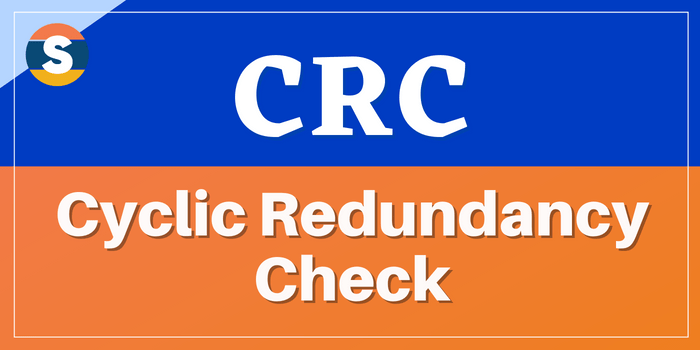
CRC Full Form in Digital Networks
CRC Full Form – The Full form of CRC is Cyclic Redundancy Check. A CRC is commonly used in digital networks and storage devices. Cyclic Redundancy Check is an error-detecting code commonly used to detect accidental changes to raw data. This is the process whereby the hardware builds a check digit(s) from the stream of data when data is transmitted and appends the check digit(s) to the end of the stream. The receiving hardware should generate identical check digit(s) which runs on the same algorithm. If not, a transmission error has occurred and remedial action must be taken. CRCs are so called because the check (data verification) value is a redundancy (it expands the message without adding information) and the algorithm is based on cyclic codes. CRCs are popular because they are simple to implement in binary hardware, easy to analyze mathematically, and particularly good at detecting common errors caused by noise in transmission channels. In 1961, W. Wesley Peterson invented the CRC; the 32-bit CRC function of Ethernet and many other standards is the work of several researchers and was published in 1975.
What is CRC (Cyclic Redundancy Check)?
A Cyclic Redundancy Check (CRC) is an error-detecting code commonly used in digital networks and storage devices to detect accidental changes to raw data. Algorithmically, it is a type of hash function that takes an input (or “message”) and returns a fixed-size string of characters, which is usually a “digest” that is unique to the original input. The idea is that any change to the input will result in a different digest, so if the input and the digest don’t match, the receiver knows that the data has been corrupted.
What are the Uses of CRC?
The CRC algorithm is used to identify mistakes in digital data transfer or storage. Based on the data being delivered, the sender determines a numerical number, known as the checksum or CRC, and adds it to the message. The checksum is then updated by the receiver using the data received, and it is then contrasted with the value received from the sender. The receiver assumes that no errors were present in the data transmission if the values line up. The receiver can ask for the data to be retransmitted if the values don’t match because this indicates that there have been errors.
Ethernet, USB, HDMI, and a variety of other communication protocols all make extensive use of CRC. To find mistakes in data that has been stored, it is also employed in storage devices like hard discs and memory cards.
Advantages of CRC (Cyclic Redundancy Check)
There are several advantages of using Cyclic Redundancy Check (CRC) to detect errors in digital data:
- High Detection Rate: CRCs can detect a wide range of errors, including single-bit errors, burst errors, and even errors that are spread across multiple bits.
- Low Overhead: CRCs use a simple mathematical algorithm that requires minimal computation and can be easily implemented in hardware or software.
- Efficient Error Detection: CRCs can detect errors quickly and efficiently, allowing for the correction or retransmission of data before it becomes corrupted.
- Versatility: CRCs can be applied to a wide range of data types, including text, images, and video, and can be used in a variety of applications, such as disk drives, memory cards, and communication protocols.
- Robustness: CRCs are robust against errors caused by noise and interference, making them suitable for use in noisy communication channels.
- A simple way to check the integrity of data, it is widely used in many communication protocols and data storage.
- It can detect burst errors of up to the size of the generator polynomial used to calculate the CRC, which makes it useful in detecting errors in data transmitted over a noisy channel.
Other Full Forms of CRC
There are a few different full forms that have been used to describe the acronym CRC, depending on the context in which it is being used. Some of the more common full forms include:
- Cyclic Redundancy Check: This is the most common full form of CRC and the one that is most closely associated with the error-detection method described above.
- Cardholder Risk Classification: In the context of credit card processing, CRC is used as an acronym for “Cardholder Risk Classification,” which refers to the process of assessing the risk of a particular cardholder or transaction.
- Cancer Registry Certification: In the field of medical research, CRC is used as an acronym for “Cancer Registry Certification,” which refers to the process of certifying that a particular cancer registry meets certain standards for data quality and completeness.
- Cyclic Redundancy Code: Another full form of the acronym CRC, referring to the error-detection method.
- Central Registry of Criminals: In some countries CRC is used as an acronym for “Central Registry of Criminals,” which refers to a database of individuals with criminal records that is maintained by a government agency.
Also,see:
- Internet Full Form, What is the Full Form of Internet?
- IMDB Full Form, What is the Full Form of IMDB?
- JAVA Full Form, What is the Full Form of JAVA?
- LTE Full Form, What is the Full Form of LTE?